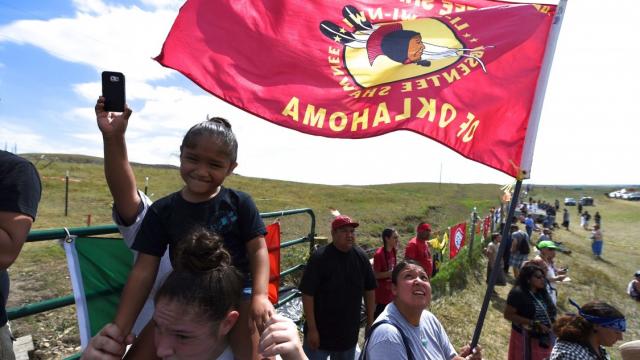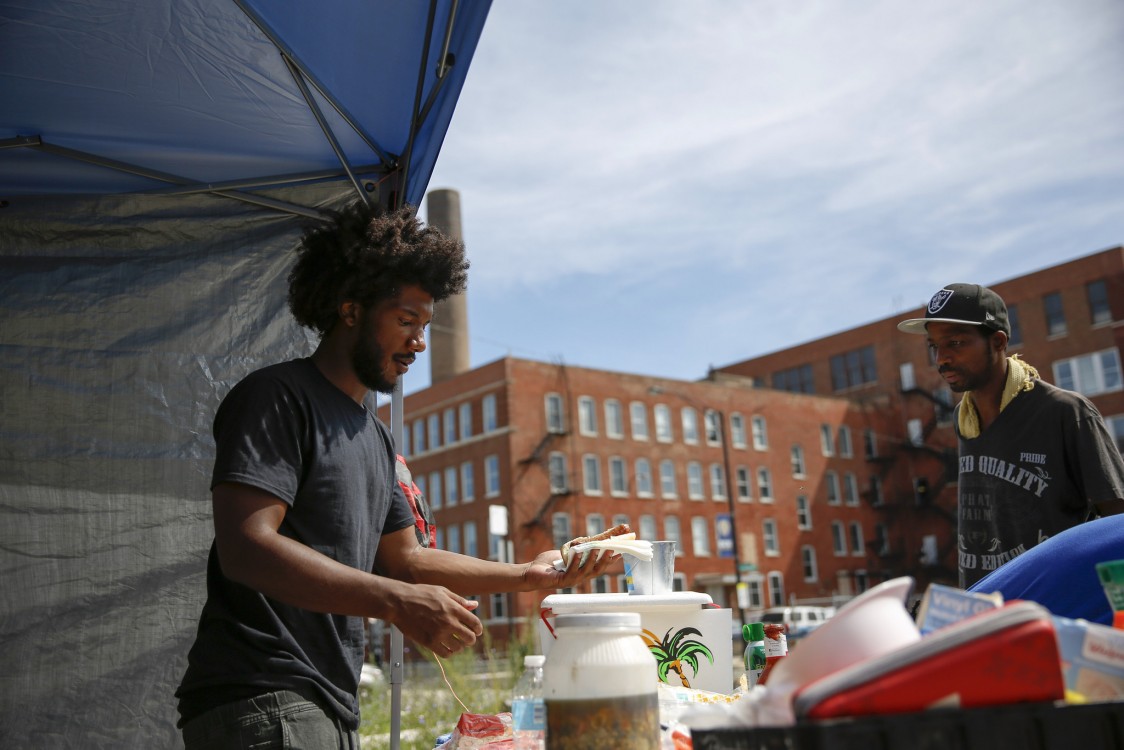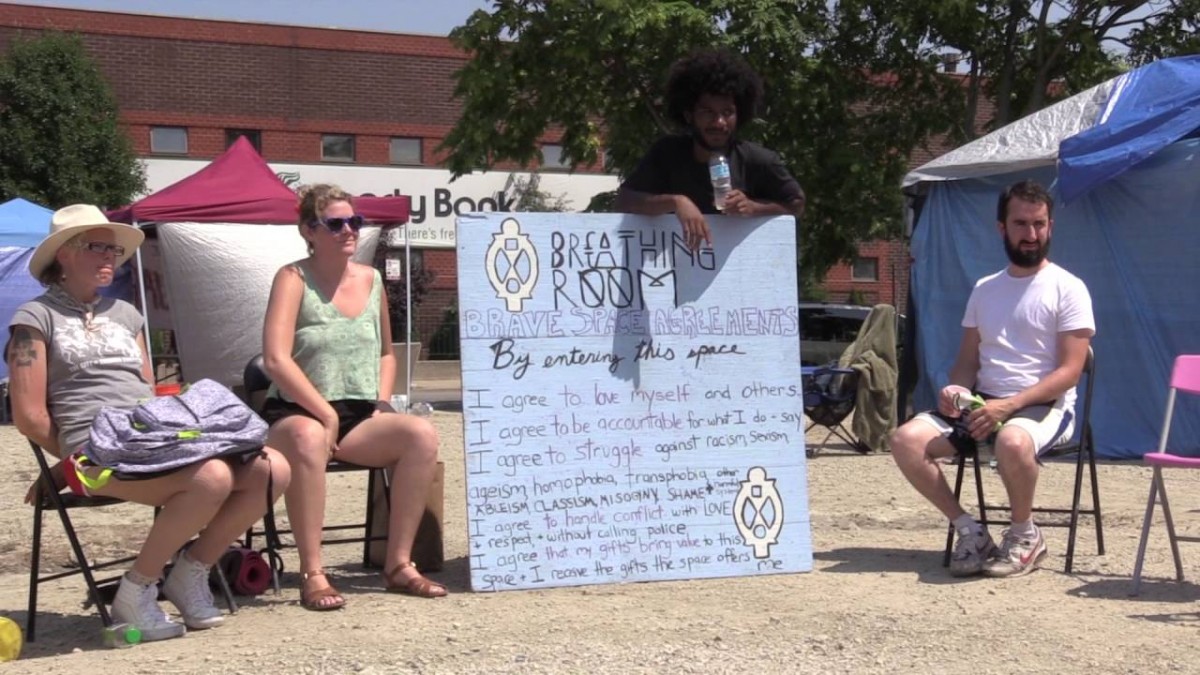
On the banks of the Cannonball River in North Dakota, far from reliable cell-phone service, a struggle is underway. Encampments that have become home to thousands stretch along both banks of the river, begun by the people of the Standing Rock reservation, who are determined to protect their water source, the Missouri River, from the Dakota Access Pipeline, which will, if built, run directly beneath the water.
But in those camps, something bigger is happening – something that is both new and familiar to observers of the social movements of the post-2008 period. “We are free at this space in time,” Faith Spotted Eagle told me. A member of the Ihanktonwan Nation, she had organized Native people for the Keystone XL pipeline fight, including work on a new treaty to protect the environment between several Native nations. She sees what’s happening in North Dakota as a process of figuring out what kind of a society people want to live in.
Spotted Eagle said the protesters are drawing on the structure of the Oceti Sakowin, the federation of Dakota, Lakota, and Nakota people that had not come together in over 100 years; they’ve rediscovered dances and songs, built a school for the children, and prayed for the water. Drumming and singing alternate with public speakers at the open mic around a campfire, and riders on horseback meander through the camp. The campers are fed by a volunteer-run kitchen stocked with donated food (the night I was there, moose was on the menu, brought by campers all the way from Maine); they talk long-term strategy, study historic treaties, and call for a different relationship to the land and the water, one where the natural world is respected for itself.
“The corporations have become individuals, the privatization has given them rights of individuals to just go out and wreak havoc,” Spotted Eagle said. “Well, the river has a right and that right is being infringed upon. Those of us that grew up along the river, we consider that a human rights violation.” What was happening, she said, was a process of decolonization, of shaking loose from the rules and patterns and laws imposed by the colonizers, by Western capitalism, on her people. In the camps along the Cannonball and Missouri, they were drawing on old traditions and new alliances alike to create a different society in that space.
The people at Standing Rock were not the only ones considering decolonization this summer. On July 12, Black Lives Matter members in Los Angeles marched to City Hall to demand a meeting with Mayor Eric Garcetti. Yet another black woman, Redel Jones, had been killed by police, and yet again, the city had ruled that the police officers who killed her had done nothing wrong. Prevented from reaching the mayor’s office, the protesters camped out on City Hall steps and remained there, pitching tents at night and offering free food, making art, dancing, doing yoga, and talking to passersby about police violence in their city.
Mayor Garcetti offered to meet with a delegation of the activists in private, but they refused and demanded that he come speak with them in their public space. They held the space for over 50 days under the banner of “Decolonize L.A. City Hall” before deciding to go mobile and track the mayor across the city with their demands. They chose the term “decolonization,” organizers said, because the “police and government structures that employ them are the occupiers.”
A bit later in July, after a protest at Chicago’s Homan Square, the infamous police black site, participants built a camp and named it“Freedom Square.” The square was designed not only as a police-free space, but a space where protesters could cook and make art and hold workshops for neighborhood youth. A first-aid station was staffed by medics, and the protesters gave away free books—symbolically important, given that Illinois is shuddering under the reign of the ultimate “austeritarian,” Bruce Rauner, the multimillionaire governor who has slashed taxes for the wealthy while aiming to turn more public services over to the private sector.
To paraphrase the Chicago Teachers Union – which faced another round of layoffs this summer – Freedom Square was a vision of the city Chicago residents deserve, held for 41 days by the #LetUsBreathe collective before they phased out and handed the space over to the residents of the surrounding North Lawndale neighborhood. “It was a project of liberation, and most of the structures that society has taught us are not liberating,” read a statement from the collective. “The occupation did not end because we ran out of energy or we were overwhelmed by the logistics of the site. It ended because it illustrated the tension between the world as it is and the world as we imagine it to be.”
On August 1, New Yorkers joined the wave, taking over City Hall Plaza for more than two weeks with demands to fire the embattled police commissioner, Bill Bratton, as well as to defund police and reinvest the money in communities. Protesters made peanut-butter-and-jelly sandwiches, chalked slogans around the square (“disarm the NYPD” and “Silence is Violence,” among others), held self-care sessions, heard from family members of those killed by the NYPD, and did outreach to arrestees at nearby Manhattan Central Booking. While they held the space, they called it “Abolition Square.”
The return of encampments as a tactic is telling us something, if we’d care to listen. Though the camps have been founded over issues as seemingly disparate as police violence against black people and the construction of a pipeline, they share more similarities than just handmade signs and speak-outs. Melina Abdullah of Black Lives Matter Los Angeles summed it up: “We’re building the community we want to live in.”
The tactic has recurred again and again since the 2008 financial crisis, as people from disparate backgrounds have rallied to challenge the inequality that is now visible all around. The workers of Republic Windows and Doors in Chicago began the trend, right before Christmas 2008. Bank of America, fresh from its multi-billion-taxpayer-dollar bailout, had been unwilling to extend credit to the company, which responded by telling its workers that they were fired. Six hundred thousand other manufacturing workers were laid off that year, but the 240 Republic workers – many of them immigrants – decided to fight. They locked themselves into the factory, refusing to leave until they got their severance pay. As a bonus, another company agreed to buy the factory and give them back their jobs. Years later, some of those workers are now the cooperative owners of the factory, renamed New Era Windows.
But it was in Wisconsin that the tactic began to take the shape that now feels so familiar. In the winter of 2011, after newly elected Republican Governor Scott Walker proposed to eliminate collective bargaining rights for the state’s public employees, protesters took over the state capitol. They held public space – the building they called the “People’s House” – and urged supporters to join them. Medics offered health services, and onlookers from around the country and the world called to order pizzas for the protesters.
The space itself served as an example of the society the protesters wanted to see one where Wisconsinites came together to take care of each other while Republican leaders were working to slash the budget for the poorest and sickest. The occupation itself, where one could see a performance by the firefighters’ bagpipe band or a Les Miserables-themed flash mob, was an alternative to austerity when at the time no politician would admit that such a thing was possible. It was about more than collective bargaining, though the “collective” part was key. In the era of privatization, when governors like Walker were using the excuse of the financial crisis and resulting state budget crunches to pare budgets to the bone and hand even more public services to private companies, these occupations declared that public spaces belonged to the people.
Occupations have their drawbacks. The same tenuousness of public space and erosion of the freedoms of political speech and action that inspire them in the first place mean that they are easily crushed by police. The crackdowns on Occupy Wall Street led many young white protesters, many of whom had begun by chanting “Cops Are the 99 Percent,” to join organizing against police brutality. But they also turned the daily battles to hold onto the space itself into the central focus, letting other organizing work slide as protesters faced rougher arrests, stiffer fines, and jail time. When demands are not met, protesters are left wondering when and how to leave without appearing to have backed down. And when the demands are utopian, when does it end?
The occupations of the past, particularly those of the labor movement, often focused on holding private spaces. Sit-down strikes were a demonstration not just of the fact that factories needed workers in order to produce, but a statement that the workers in fact had as much claim to the space as the owners did. Sit-ins during the Civil Rights movement aimed to end segregation in private businesses. When college students held space at Columbia University for a week in 1968, they demanded the private university end its research that went toward the war in Vietnam and end its encroachment on public space in its Morningside Heights neighborhood.
But the encampments of the post-2008 period reflect a current shift in politics, one that demands an end to the skyrocketing inequality that came from privatization, the crushing of unions, tax cuts for the wealthy, and a rapidly swelling prison population. In a moment when we are told that there is not enough for us, these camps give away food and books. In a moment when cities consider selling public art to fill budget holes and Sesame Street, the famed public program, has moved to HBO, the occupations make art (and children’s art in particular) a key part of their spaces. In a time where we are atomized and polarized, where our political choices are reduced to checking a box at election time, people come together to be political, in public, together. We are supposed to be sad and afraid, but protesters make music and dance. They assert that this is what public space is for.
Margaret Thatcher across the Atlantic epitomized the ideology of the past few decades when she infamously declared, “There’s no such thing as society. There are individual men and women and there are families. And no government can do anything except through people, and people must look after themselves first.”
That declaration was to justify decades of budget-cutting, union-busting, and privatization of public services, both in Europe and the United States. Politicians argued – and continue to argue – that privatization will bring efficiency to public services and will be a solution to budget holes in times of economic downturn. But privatization, as a new report from the policy center In The Public Interest shows, helped to create the problems that are now driving people to take action.
“When they are privatized, public goods that were meant to serve everyone can morph into separate and unequal systems that further divide communities and perpetuate inequality,” the report notes. The privatization of public space, in particular, “perpetuates economic and racial segregation. Instead of creating spaces where people of diverse socioeconomic and racial backgrounds can come together, the embedding of private money and interests into select parks and green spaces has the impact of further separating higher-income individuals and families from poor individuals and families that are often people of color.”
The spaces being claimed by today’s social movements are set up in deliberate contrast to that ethos. When police came to tell the protesters at Decolonize City Hall in Los Angeles that they needed to leave, the officer informed them that the public plaza they held “becomes private space after 7 p.m. when the businesses are closed.” (They refused to leave.) It is a neat bit of irony that the unique rules governing New York’s so-called “public-private spaces”—public space paid for and managed by corporations as part of otherwise sweet land deals—allowed first Occupy Wall Street, and then Abolition Square, to remain. The privatized public spaces are open 24 hours, while city-owned “public” spaces have closing times.
The attacks on “society” have been about more than just the shuffling of public money and spaces into private hands, of course. In Wisconsin, the takeover of the “People’s House” was a response to an attack on public-sector workers—the teachers and social workers and librarians who maintain our few remaining public spaces, who cultivate connections between people. That attack came double-pronged with cuts to the budgets of those public institutions, leaving a society that works increasingly only for those who can afford it.
A side effect of the shrinking of labor unions over the past several decades—a phenomenon that burst into the public consciousness when Thatcher’s American counterpart, Ronald Reagan, broke the air traffic controllers’ union — was the disappearance of connections between working people, of places to be political, together, in public. The stepped-up rhetoric of the era lauded competition couched in the language of entrepreneurship: You don’t need a union, when you can be your own boss! Who needs solidarity when you have a “flexible” workplace? Working people wind up more atomized from one another, lacking a common location and language to deal with their problems.
Today, as people come together and take over public squares and parks and vacant lots, they are defiantly declaring that there is a society, and that it can be other than it is now. They are declaring that the state’s role is not in policing citizens but in providing for them. And they’re declaring that people can in fact look after one another, that there are other motives besides making money.
From Standing Rock to Chicago, Los Angeles to New York, today’s movements return again and again to the tactic of holding space, building community, and caring for one another in public. It is often a mistake to assume that one or another of a movement’s tactics encapsulate that movement. But this common thread runs through several of the popular uprisings of the past eight years, and if we look closely at it, we can gain a clearer view not only of the world that people are protesting, but the one they want to build.
3 WAYS TO SHOW YOUR SUPPORT
- Log in to post comments













